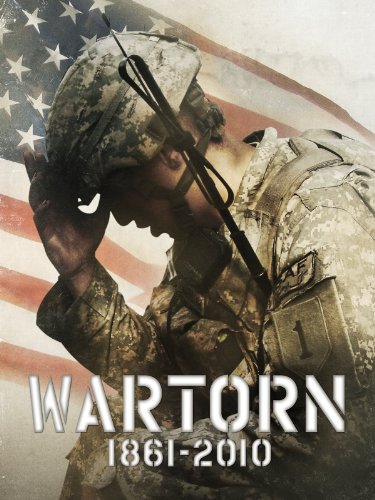by Bryan & Heather
While neither of us specialized in psychology, “soldier experience,” or memory studies in the course of our history education, our friend and mentor Ian Isherwood worked extensively in the latter two, and his course Aftermath: The Experience of War in Modern Memory was one we remember fondly. Working at various sites of the American Civil War also led us into close contact with these subject areas, and Bryan’s studies of military history more generally has led to at least a passing familiarity as well. Thus when we discovered a documentary on Max exploring soldiers’ psychological trauma throughout the last one and half centuries of warfare, we were intrigued. While Wartorn 1861-2010 turned out to be much more focused on recent conflicts than we had expected, we still found it to be an approachable, respectful, and largely responsible effort at bringing these men’s experiences into the public eye.
As one might be able to glean from its poster, Wartorn takes as its focus the stories of American servicemen and -women in its 21st Century-conflicts, primarily the invasions of Afghanistan and Iraq. Through interviews with active service personnel, mental health professionals, veterans, and their family members, the filmmakers attempt to show and contextualize the human face of a social issue that continued to affect many Americans years after their part in these conflicts–and indeed the conflicts themselves–have drawn to a close. The trials of those who deal with the most severe form of trauma, clinically diagnosed as PTSD (post-traumatic stress disorder) of course form the spine of these stories, yet Wartorn admirably portrays trauma and the altering effects of serving in high-stress combat situations as a larger spectrum, talking with individuals who have undergone subtle personality changes or have trouble connecting with others alongside those with more serious symptoms of breakdowns and suicidal ideation. The conduct and presentation of these interviews also impressed us; while they necessarily deal with events that are uncomfortable to listen to, let alone recount, the filmmakers take pains to be sympathetic rather than exploitative or judgmental.
Wartorn’s efforts to situate these modern experiences in a longer historical spectrum of soldiers’ trauma, however, was not all we hoped it might be. Each era of conflict, from the American Civil War through both world wars to Vietnam, are given a single segment wherein overlay text informs viewers of what “it” (left ambiguous whether that’s general psychological trauma or, more problematically, PTSD specifically) was called in that era, followed by one or two contemporary accounts of what it looked like in practice. While this had the intended effect of highlighting just how similar all these soldiers’ stories were and are, it unfortunately spent too little time on each time period to really delve into the details of these disorders and how they each differed in key ways from one another based on the evolving nature of modern combat. That said, Wartorn’s interviews with surviving veterans of the Second World War was a fascinating inclusion we’ve seldom seen in this kind of material, and argued persuasively for more continuity over the past decades than we had heretofore recognized.
While Wartorn was not quite as historical or groundbreaking as we had hoped it might be going in, it remains a solid introduction to the field of soldiers’ experiences and traumas in modern warfare. As always with this subject matter, viewers should be aware that the stories it contains can be upsetting, but they are well worth the watch if you can stomach them.
